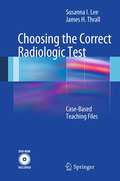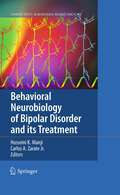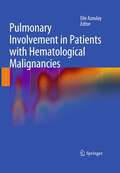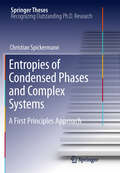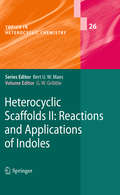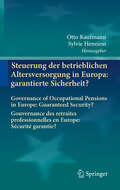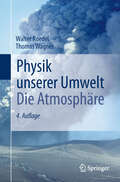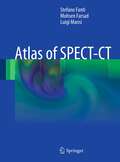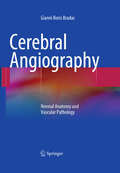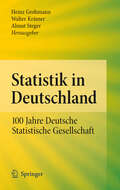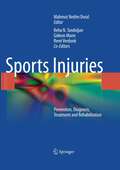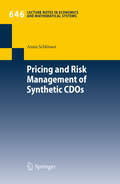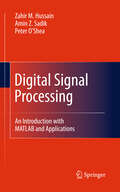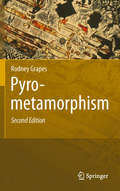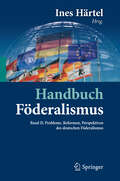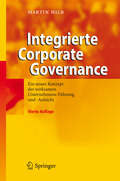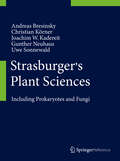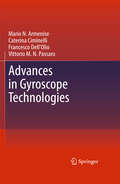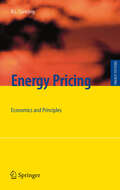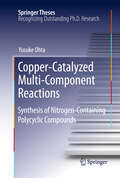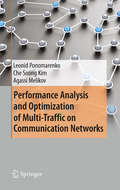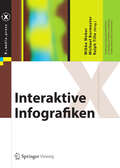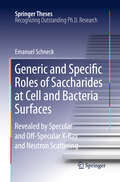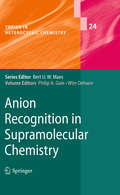- Table View
- List View
Choosing the Correct Radiologic Test: Case-Based Teaching Files
by James H. Thrall Susanna LeeOwing to financial constraints, greater pressure is being put on physicians to order only appropriate radiologic exams. The American College of Radiology (ACR) Appropriateness Criteria have emerged as a widely accepted standard by which the appropriate use of radiologic exams is judged. This book enables physicians and trainees to learn the ACR recommendations in a clinically relevant and intellectually stimulating way. More than 400 clinical scenarios are organized into ten modules based on organ systems. Each scenario is addressed by means of an interactive quiz in which the reader is invited to select the best option from various imaging modalities. Each choice is given a numerical rating of appropriateness, with accompanying comments when necessary. Correlative images of pathologies are included to enhance the reader's appreciation of the diagnostic power of the modality in question. This book is ideal as a tool both for self-study and for quantitative evaluation of students' knowledge.
Behavioral Neurobiology of Bipolar Disorder and its Treatment (Current Topics in Behavioral Neurosciences #5)
by Husseini K. Manji Carlos A. Zarate Jr.This book offers the most up-to-date information about research surrounding the neurobiology of bipolar disorder as well as currently available and novel therapeutic options. The volume has assembled a widely respected group of preclinical and clinical researchers who bring their expertise to bear upon this illness by reviewing cutting-edge research and clinical evidence regarding the pathophysiology and treatment of bipolar disorder. Early chapters review the course and outcome and genetics of this highly heritable condition, including chapters on epigenetics and clinical endophenotypes. Several chapters offer a remarkably thorough and unique overview of the neurobiology of the disorder, including what is known from neuroimaging work and the development of animal models. Finally, the book covers treatment strategies for bipolar disorder, including both traditional and novel therapeutics, as well as non-pharmacological treatments. It offers both researchers and clinicians key insights into this devastating disorder.
Pulmonary Involvement in Patients with Hematological Malignancies
by Elie AzoulayThe number of patients treated for hematological malignancies is increasing steadily. To maximize cure rates, aggressive treatments have been introduced, including high-dose chemotherapy, stem cell transplantation, and targeted therapies. As a result, overall and disease-free survival rates have improved substantially, but at the price of life-threatening toxic and infectious complications that chiefly target the lung. This book provides clinicians caring for patients with hematological malignancies with detailed, up-to-date information on all relevant aspects of pulmonary involvement. Individual sections are devoted to epidemiology, diagnostic strategy, lung infections, non-infectious pulmonary involvement, and treatment, including decision making in patients with acute respiratory failure. Each of these sections contains a number of chapters, all written by leading international experts. In addition, the reader's attention is drawn to important "pearls" relating to each condition.
Entropies of Condensed Phases and Complex Systems
by Christian SpickermannPredicting thermodynamic quantities for chemically realistic systems on the basis of atomistic calculations is still, even today, a nontrivial task. Nonetheless, accurate treatment of inter-particle interactions, in terms of quantum chemical first principles methods, is a prerequisite for many applications, because of the complexity of both reactants and solvents in modern molecular sciences. Currently, a straightforward calculation of thermodynamic properties from these methods is only possible for high-temperature and low- density systems. Although the enthalpy of a system can often be predicted to a good level of precision with this ideal gas approach, calculating the entropy contribution to the free energy is problematic, especially as the density of the system increases. This thesis contains a compact and coherent introduction of basic theoretical features. The foundations are then laid for the development of approaches suitable for calculation of condensed phase entropies on the basis of well-established quantum chemical methods. The main emphasis of this work is on realistic systems in solution, which is the most important environment for chemical synthesis. The presented results demonstrate how isolated molecular concepts typically employed in modern quantum chemistry can be extended for the accurate determination of thermodynamic properties by means of scale- transferring approaches.
Heterocyclic Scaffolds II:
by Gordon W. GribbleRichard J. Sundberg Electrophilic Substitution Reactions of Indoles Tara L.S. Kishbaugh Reactions of Indole with Nucleophiles Erin Pelkey Metalation of Indole Jie Jack Li Gordon W. Gribble Metal-Catalyzed Cross-Coupling Reactions for Indoles Jeanese C. Badenock Radical Reactions of Indole Fariborz Firooznia Robert F. Kester Steven J. Berthel [2+2], [3+2] and [2+2+2] Cycloaddition Reactions of Indole Derivatives Robert F. Kester Steven J. Berthel Fariborz Firooznia [4+2] Cycloaddition Reactions of Indole Derivatives Jonathon S. Russel Oxindoles and Spirocyclic Variations: Strategies for C3 Functionalization Liangfeng Fu Advances in the Total Syntheses of Complex Indole Natural Products
Steuerung der betrieblichen Altersversorgung in Europa: garantierte Sicherheit?
by Sylvie Hennion Otto KaufmannNahezu alle europäischen Staaten haben ihre Alterssicherungssysteme reformiert mit dem Ziel, sie zu konsolidieren. Die betriebliche Altersversorgung ist seitdem zu einem Schwerpunkt betrieblicher Sozialpolitik geworden. Bei der Errichtung, Durchführung und der Kontrolle betrieblicher Altersversorgungssysteme stellen sich zahlreiche Rechtsfragen. In dem Werk wird das Zusammenwirken der Sozialpartner analysiert. Es wird aufgezeigt, welche Handlungsspielräume bestehen und welche Kontroll- und Entscheidungskompetenzen jeweils eingeräumt werden.
Physik unserer Umwelt: Die Atmosphäre
by Thomas Wagner Walter RoedelDas Buch basiert auf einer zweisemestrigen Vorlesung an der Universität Heidelberg über die Physik der Atmosphäre. Der Autor erklärt einerseits das System Atmosphäre und vermittelt andererseits umweltrelevante Aspekte. Die Neuauflage wurde zum Teil grundlegend überarbeitet. So wurden für die Kapitel zu Spurenstoffen und zur Klimamodellierung die neuesten Forschungserkenntnisse eingearbeitet, das Kapitel über Aerosole um Abschnitte zu deren chemischer Bedeutung ergänzt. Mit umfangreichem Register sowie ausführlichen Quellen- und Literaturangaben.
Atlas of SPECT-CT
by Mohsen Farsad Stefano Fanti Luigi MansiThe field of nuclear medicine has evolved rapidly in recent years, and one very important aspect of this progress has been the introduction of hybrid imaging systems. PET-CT has already gained widespread acceptance in many clinical settings, especially within oncology, and now SPECT-CT promises to emulate its success. Useful applications of this new approach have been identified not only in oncology but also in endocrinology, cardiology, internal medicine, and other specialties. This atlas, which includes hundreds of high-quality images, is a user-friendly guide to the optimal use and interpretation of SPECT-CT. The full range of potential SPECT-CT applications in clinical routine is considered and assessed by acknowledged experts. The book is designed to serve as a reference text for both nuclear physicians and radiologists; it will also provide fundamental support for radiographers, technologists, and nuclear medicine and radiology residents.
Cerebral Angiography: Normal Anatomy and Vascular Pathology
by Gianni Boris BradacThis revised and enlarged edition of Cerebral Angiography, which includes new angiographic studies and illustrative drawings, offers detailed guidance on diagnostic use of the procedure. The first part of the book describes the normal anatomy of the cerebral arteries and veins, with attention to morphological aspect, embryological development, function and vascular territories. The intraorbital and extracranial vascularization is also considered. The reader will gain a sound knowledge of normal vascular anatomy and its variations that will serve as a basis for the correct interpretation of pathological processes and their clinical significance, as covered in the second part of the book. Among the pathologies considered are vascular abnormalities, including angiomas, fistulas and aneurysms; atherosclerotic and non-atherosclerotic stenosis and occlusion of the cerebral vessels; venous thrombosis; intraorbital and extracranial vascular malformations. Pathogenesis, morphological and dynamic aspects, responsible for clinical symptoms and influencing the therapy are described. While the emphasis throughout is on the diagnostic value of cerebral angiography, many examples of endovascular treatment in different pathological situations are also presented, with discussion of indications, risks and results.
Statistik in Deutschland
by Walter Krämer Heinz Grohmann Almut StegerDer Band bietet eine allgemein verständliche Übersicht über 100 Jahre Deutsche Statistische Gesellschaft (DStatG). In 17 Kapiteln schildern anerkannte Experten, wie die DStatG zur Begründung und Fortentwicklung der deutschen Wirtschafts- und Sozialstatistik und zu methodischen Innovationen wie neuere Zeitreihen-, Preisindex- oder Stichprobenverfahren beigetragen hat. Weitere Themen sind die Rolle der DStatG bei der Zusammenführung der Ost- und Weststatistik sowie die Vorbereitung und Durchführung der letzen und der aktuellen Volkszählung.
Sports Injuries
by René Verdonk Gideon Mann Mahmut Nedim Doral Reha N. TandoğanIn recent years, research studies into sports injuries have provided healthcare professionals with a better understanding of their etiology and natural history. On this basis, novel concepts in the diagnosis and management of these conditions are now being explored. This timely book offers a complete guide to the latest knowledge on the diagnosis and treatment of the full range of possible sports injuries. Individual sections are devoted to biomechanics, injury prevention, and the still emerging treatment role of growth factors, which foster more rapid tissue healing. Sports injuries of each body region are then examined in detail, with special attention to diagnostic issues and the most modern treatment techniques. In addition, pediatric sports injuries, extreme sports injuries, the role of physiotherapy, and future developments are extensively discussed. All who are involved in the care of patients with sports injuries will find this textbook to be an invaluable, comprehensive, and up-to-date reference.
Pricing and Risk Management of Synthetic CDOs
by Anna SchlösserThis book considers the one-factor copula model for credit portfolios that are used for pricing synthetic CDO structures as well as for risk management and measurement applications involving the generation of scenarios for the complete universe of risk factors and the inclusion of CDO structures in a portfolio context. For this objective, it is especially important to have a computationally fast model that can also be used in a scenario simulation framework. The well known Gaussian copula model is extended in various ways in order to improve its drawbacks of correlation smile and time inconsistency. Also the application of the large homogeneous cell assumption, that allows to differentiate between rating classes, makes the model convenient and powerful for practical applications. The Crash-NIG extension introduces an important regime-switching feature allowing the possibility of a market crash that is characterized by a high-correlation regime.
Digital Signal Processing
by Peter O’shea Amin Z. Sadik Zahir M. HussainIn three parts, this book contributes to the advancement of engineering education and that serves as a general reference on digital signal processing. Part I presents the basics of analog and digital signals and systems in the time and frequency domain. It covers the core topics: convolution, transforms, filters, and random signal analysis. It also treats important applications including signal detection in noise, radar range estimation for airborne targets, binary communication systems, channel estimation, banking and financial applications, and audio effects production. Part II considers selected signal processing systems and techniques. Core topics covered are the Hilbert transformer, binary signal transmission, phase-locked loops, sigma-delta modulation, noise shaping, quantization, adaptive filters, and non-stationary signal analysis. Part III presents some selected advanced DSP topics.
Pyrometamorphism
by Rodney Grapes1000 °C) and low pressures (< 2 kb) and typically results in the formation of "burnt" and fused rocks termed buchites, paralavas, clinkers and fulgarites. It is typically associated with shallow basaltic intrusions (contact aureoles, xenoliths,) combustion of carbonaceous matter, lightning strikes, and is also found in meteorites. During pyrometamorphism, the sequence of heating and cooling is greatly condensed favouring the preservation of a variety of stranded reaction microstructures that reflect disequilibrium reaction kinetics with metastable and mineral crystallisation. This second edition includes the latest developments in the study of pyrometamorphism derived from over 60 new references and accompanied with over 20 new illustrations.
Setting Up Wholly Foreign Owned Enterprises in China
by Andy Scott Sam Woollard Chris Devonshire-EllisDo you want to manufacture or trade in China? If you are looking at investing in a China manufacturing or service operation in China, then this book is for you. This Guide is a practical overview for the international businessman to understand the rules, regulations and management issues regarding establishing wholly foreign owned enterprises in China. We will help you to understand the implications of what can initially appear be a complicated and contradictory subject. This book tells you the basics of what you need to know, and point you at the structures you should use as well as some of the pitfalls. This book is the second in our new series of books on doing business in China, which will progressively cover such topics as setting up joint ventures, tax, IP and many other vital issues for foreign investors in this exciting market.
Handbuch Föderalismus - Föderalismus als demokratische Rechtsordnung und Rechtskultur in Deutschland, Europa und der Welt
by Ines HärtelBand I behandelt die historische Entwicklung, die philosophischen und rechtlichen Grundlagen, die politische Dimension und die ökonomische Grammatik des Föderalismus. Er stellt differenziert Inhalte und Strukturen der bundesstaatlichen Ordnung in Deutschland dar. Zudem zeigt er die Bedeutung von Rechtskultur, Verfassung und Kompetenzverteilung für den Föderalismus auf.
Integrierte Corporate Governance
by Martin HilbDer Autor stellt einen innovativen Gestaltungs- und Controllingansatz für die Unternehmensaufsicht vor. Die Instrumente, die er entwickelt und erprobt hat, behandeln Fragen der Boardstrategie und -kooperation, Auswahl, Zusammensetzung, Beurteilung, Honorierung und Förderung von Board- und Vorstandsmitgliedern sowie der Evaluation von Führungsgremien. Mithilfe von vier Bausteinen werden bisher weitgehend isoliert betrachtete Aspekte der Corporate Governance integriert. Seine Konzepte illustriert der Autor anhand von Fallstudien und Praxisberichten.
Strasburger's Plant Sciences
by Christian Körner Joachim W. Kadereit Andreas Bresinsky Gunther Neuhaus Uwe SonnewaldThis famous book on botany was published for the first time in 1894 by Eduard Strasburger and his co-workers. The present edition is based on a translation of the 36th edition of the German "Strasburger" and contains additional contributions by renowned experts in the field. The Strasburger comprises a highly appealing and holistic approach to the structure, the systematics and evolution, the functioning, and ecology of plants. The book covers 14 chapters bundled into four main sections: (i) Molecular and morphological structure of plants and cells (ii) Physiology and metabolism (iii) Evolution and systematics of plants (iv) Ecology"
Advances in Gyroscope Technologies
by Vittorio M. Passaro Mario N. Armenise Francesco Dell'Olio Caterina CiminelliThis monograph collects and critically reviews the main results obtained by the scientific community in gyroscope technologies research field. It describes architectures, design techniques and fabrication technology of angular rate sensors proposed in literature. MEMS, MOEMS, optical and mechanical technologies are discussed together with achievable performance. The book also consideres future research trends aimed to cover special applications. The book is intended for researchers and Ph.D. students interested in modelling, design and fabrication of gyros. The book may be a useful education support in some university courses focused on gyro technologies.
Energy Pricing: Economics and Principles
by Roger L. ConklingThis book describes the processes through which rates for energy consumption are derived, ranging from initial analyses of the supply and demand parameters to the final forms and levels of end-use consumer prices. The author argues against aggressive accounting procedures, and suggests criteria for choosing firm's position on pending public policy issues. A handbook on energy formulae for non-professionals is included in the book. The author is adjunct professor at the University of Portland.
Copper-Catalyzed Multi-Component Reactions: Synthesis of Nitrogen-Containing Polycyclic Compounds (Springer Theses)
by Yusuke OhtaA copper-catalyzed direct synthesis of 2-(aminomethyl)indoles by catalytic domino reaction including multi-component coupling was developed, and is the first example of a three-component indole formation without producing salts as a byproduct. Based on this reaction, a copper-catalyzed synthesis of 3-(aminomethyl)isoquinoline was accomplished which represents an unprecedented isoquinoline synthesis through a four-component coupling reaction. Following these results, extensive application studies using one-pot palladium-, acid-, or base-promoted cyclization revealed that indole- or isoquinoline-fused polycyclic compounds can be readily synthesized through multi-component reactions. As the concept of Green Chemistry becomes ever more important, these findings may provide efficient and atom-economical approaches to the diversity-oriented synthesis of bioactive compounds containing a complex structure. This could lead to development of promising drug leads with structural complexity. The work of this thesis will go on to inspire the synthetic research of many readers.
Performance Analysis and Optimization of Multi-Traffic on Communication Networks
by Leonid Ponomarenko Agassi Melikov Che Soong KimPromptly growing demand for telecommunication services and information interchange has led to the fact that communication became one of the most dynamical branches of an infrastructure of a modern society. The book introduces to the bases of classical MDP theory; problems of a finding optimal САС in models are investigated and various problems of improvement of characteristics of traditional and multimedia wireless communication networks are considered together with both classical and new methods of theory MDP which allow defining optimal strategy of access in teletraffic systems. The book will be useful to specialists in the field of telecommunication systems and also to students and post-graduate students of corresponding specialties.
Interaktive Infografiken
by Michael Burmester Ralph Tille Wibke WeberIn einer Welt der Multimedialität gewinnt ein Visualisierungstyp zunehmend an Bedeutung: die interaktive Infografik. Sie wird im Journalismus ebenso eingesetzt wie in der Unternehmenskommunikation. Dieses Buch führt auf Grundlage aktueller Forschungserkenntnisse in Theorie, Design und Rezeption von interaktiven Infografiken ein: Wie werden sie wahrgenommen? Welche Vorteile bieten sie für das Verstehen und Behalten von Inhalten? Gibt es Gestaltungs- und Erzählmuster? Welche Methoden wenden Infografiker an? Mit Beispielen und Tipps von Experten.
Generic and Specific Roles of Saccharides at Cell and Bacteria Surfaces
by Emanuel SchneckSystematic investigations of the structure, mechanics, and dynamics of biological surfaces help us understand more about biological processes taking place at cell and bacteria surfaces. Presented here is a study of the role membrane-bound saccharides play in the modulation of interactions between cells/bacteria and their environments. In this thesis, membrane structures were probed perpendicular and parallel to the surface, and sophisticated planar models of biomembranes composed of glycolipids of various structural complexities were designed. Furthermore, specular and off-specular X-ray and neutron scattering experiments were carried out. This research has led to the development of several new methods for extracting information on the structure and mechanics of saccharide-rendered biomembranes from the measured scattering signals. In fact, more is now known about the influence of the saccharide structure. These results demonstrate that the study of planar model systems with X-ray and neutron scattering techniques can provide comprehensive insight into the structure and mechanics of complex biological surfaces.
Anion Recognition in Supramolecular Chemistry (Topics in Heterocyclic Chemistry #24)
by Philip A. Gale Wim DehaenBrett M. Rambo Eric S. Silver Christopher W. Bielawski Jonathan L. Sessler Covalent Polymers Containing Discrete Heterocyclic Anion Receptors Philip A. Gale Chang-Hee Lee Calix[n]pyrroles as Anion and Ion-Pair Complexants Wim Dehaen Calix[n]phyrins: Synthesis and Anion Recognition Hiromitsu Maeda Acyclic Oligopyrrolic Anion Receptors Jeffery T. Davis Anion Binding and Transport by Prodigiosin and Its Analogs Hemraj Juwarker Jae-min Suk Kyu-Sung Jeong Indoles and Related Heterocycles Pavel Anzenbacher Jr. Pyrrole-Based Anion Sensors, Part I: Colorimetric Sensors Pavel Anzenbacher Jr. Pyrrole-Based Anion Sensors, Part II: Fluorescence, Luminescence, and Electrochemical Sensors Ermitas Alcalde Immaculada Dinarès Neus Mesquida Imidazolium-Based Receptors Nathan L. Kilah Paul D. Beer Pyridine and Pyridinium-Based Anion Receptors Kevin P. McDonald Yuran Hua Amar H. Flood 1,2,3-Triazoles and the Expanding Utility of Charge Neutral CHlllAnion Interactions
